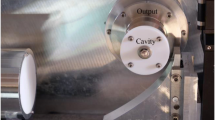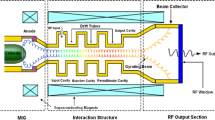Abstract
We present an internal mode converter (IMC) design for a 1.5 MW, 110 GHz gyrotron operating in the TE22,6 mode. The launcher, designed using the codes Surf3d and LOT, converts the cavity waveguide mode into a nearly pure Gaussian beam. The Gaussian beam output from the launcher is shaped by a series of 4 smooth, curved mirrors to provide a circular output beam with a flat phase front at the gyrotron window. By employing smooth mirrors rather than mirrors with phase correcting surfaces, such an IMC is less sensitive to alignment issues and can more reliably operate with high efficiency. The IMC performance was verified by both cold test and hot test experiments. Beam pattern measurements in each case were in good agreement with theoretical predictions. The output beam was of high quality with calculations showing that the Gaussian Beam content was 95.8 ± 0.5% in both hot and cold test.











Similar content being viewed by others
References
V. E. Zapevalov and M. A. Moiseev, “Influence of aftercavity interaction on gyrotron efficiency,” Radiophysics and Quantum Electronics, 47, 520-527 (2004).
E. M. Choi, M. A. Shapiro, J. R. Sirigiri, and R. J. Temkin, “Experimental observation of the effect of aftercavity interaction in a depressed collector gyrotron oscillator,” Physics of Plasmas, 14, 093302 (2007).
D. S. Tax et al, “Mode conversion losses in ITER transmission lines,” Proc. Of 33rd Intl. Conf. IR, MM and THz Waves, Sept 2008, 10.1109/ICIMW.2008.4665590 (2008).
K. Ohkubo, S. Kubo, H. Idei, M. Sato, T. Shimozuma, and Y. Takita, “Coupling of tilting gaussian beam with hybrid mode in the corrugated waveguide,” International Journal of Infrared and Millimeter Waves, 18 (1), 23-41 (1997).
M. A. Shapiro, E. J. Kowalski, J. R. Sirigiri, D. S. Tax, R. J. Temkin, T. S. Bigelow, J. B. Caughman, and D. A. Rasmussen, “Loss estimate for ITER ECH transmission line including multimode propagation,” Fusion Science and Technology, 57 (3), 196-207 (2010).
J. M. Neilson, “Optimal synthesis of quasi-optical launchers for high-power gyrotrons,” IEEE Transactions on Plasma Science, 34, 635-641 (2006).
A. A. Bogdashov and G. G. Denisov, “Asymptotic theory of high-efficiency converters of higher-order waveguide modes into eigenwaves of open mirror lines,” Radiophysics and Quantum Electronics, 47 (4), 283-296 (2004).
M. Blank, K. Kreischer, and R. J. Temkin, “Theoretical and experimental investigation of a quasi-optical mode converter for a 110-GHz gyrotron,” IEEE Transactions on Plasma Science, 24 (3), 1058-1066 (1996).
M. P. Perkins, R. Cao, J. M. Neilson, R. J. Vernon, “A high efficiency launcher and mirror system for use in a 110 GHz TE22,6 mode gyrotron,” International Journal of Infrared and Millimeter Waves, 28 (3), 207-218 (2007).
A. V. Chirkov, G. G. Denisov, and N. L. Aleksandrov, “3D wavebeam field reconstruction from intensity measurements in a few cross sections,” Optics Communications, 115, 449-452 (1995).
D. R. Denison, T. S. Chu, M. A. Shapiro, and R. J. Temkin, “Gyrotron internal mode converter reflector shaping from measured field intensity,” IEEE Transactions on Plasma Science, 27 (2), 512-519 (1999).
J. M. Neilson, “Surf3D and TOL: computer codes for design and analysis of high-performance QO launchers in gyrotrons,” 29th International Conference on Infrared and Millimeter Waves, Karlsruhe, Germany, 667-668, Sept. 27 – Oct. 1, 2004.
J. M. Neilson and R. Bunger, “Surface integral equation analysis of quasi-optical launchers,” IEEE Transactions on Plasma Science, 30 (3), 794-799 (2002).
C. Moeller, “A coupled cavity whispering gallery mode transducer,” Conf. Digest 17th Int. Conf. on Infrared and Millimeter Waves, Pasadena, CA, M3.7 (Dec. 1992).
P. F. Goldsmith, Quasioptical Systems: Gaussian Beam Quasioptical Propagation and Applications, Wiley Publisher, 1998.
D. H. Martin and J. W. Bowen, “Long-wave optics,” IEEE Transactions on Microwave Theory and Techniques, 41(10), 1676-1690 (1993).
Acknowledgements
The authors would like to thank Monica Blank and Philipp Borchard of CPI for the fabrication of the launcher and D. Minerath and R. Vernon of the University of Wisconsin for their work on the launcher cold test. This work was supported by the Department of Energy, Office of Fusion Energy Sciences.
Author information
Authors and Affiliations
Corresponding author
Additional information
An erratum to this article can be found at http://dx.doi.org/10.1007/s10762-011-9803-8
Rights and permissions
About this article
Cite this article
Tax, D.S., Choi, E.M., Mastovsky, I. et al. Experimental Results on a 1.5 MW, 110 GHz Gyrotron with a Smooth Mirror Mode Converter. J Infrared Milli Terahz Waves 32, 358–370 (2011). https://doi.org/10.1007/s10762-010-9720-2
Received:
Accepted:
Published:
Issue Date:
DOI: https://doi.org/10.1007/s10762-010-9720-2




